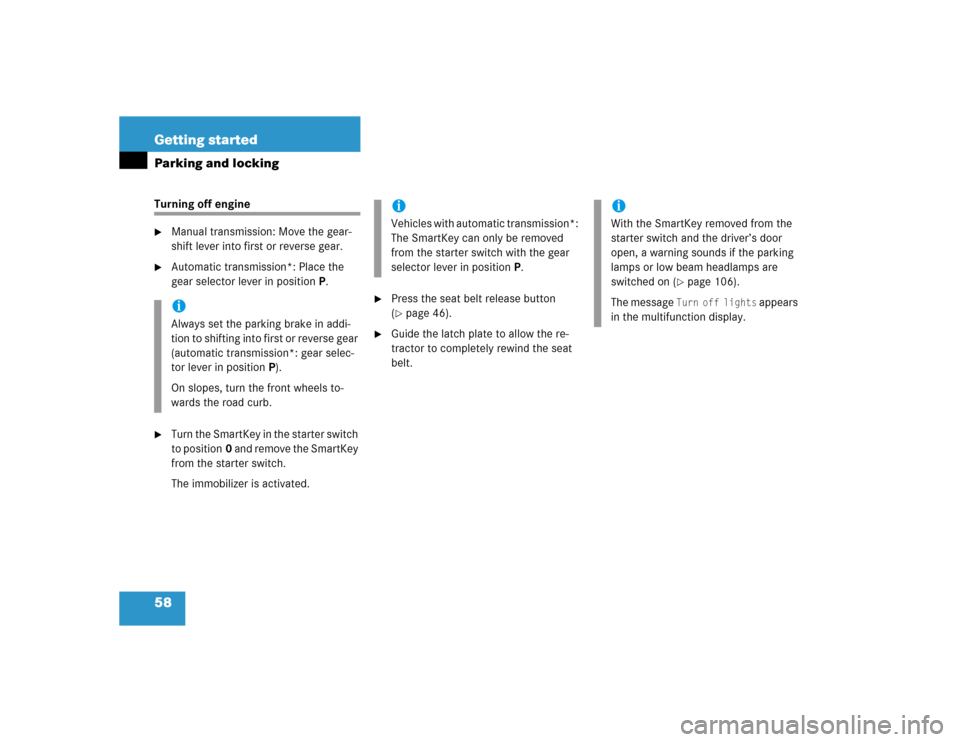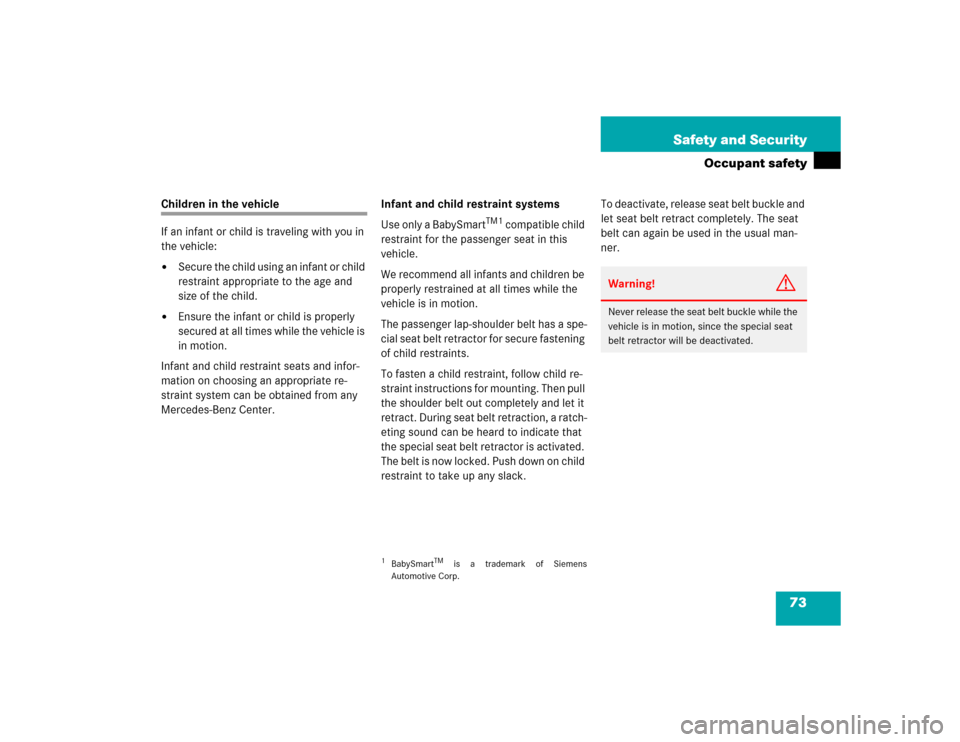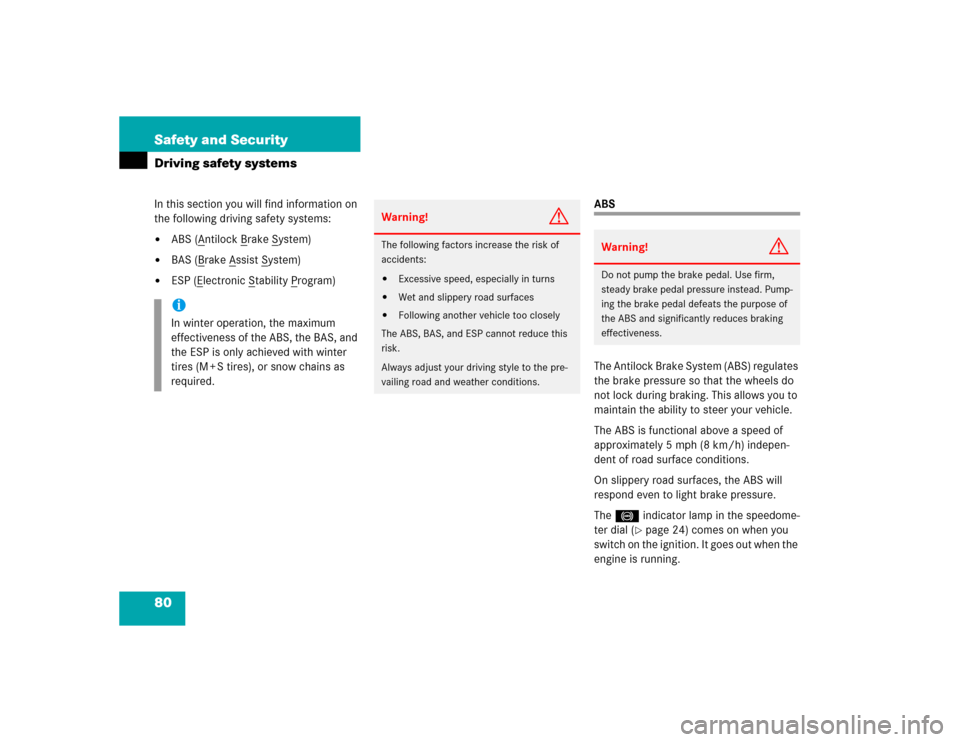Page 51 of 464

51 Getting started
Driving
Manual transmission�
Depress the brake pedal.
�
Fully depress the clutch pedal.
�
Move gearshift lever to first gear to
drive forward, or to reverse gear to
drive rearward.
�
Simultaneously release the brake pedal
and slowly the clutch pedal.
�
Carefully depress the accelerator
pedal.Automatic transmission*
�
Depress the brake pedal.
The gear selector lever lock is released.
�
Move gear selector lever to positionD
to drive forward, or to positionR to
drive rearward.
�
Release the brake pedal.
�
Carefully depress the accelerator
pedal.!Wait for the gear selection process to
complete before setting the vehicle in
motion.iDuring the brief warm-up, transmission
upshifting is delayed. This allows the
catalytic converter to heat up more
quickly to operating temperature.
Warning!
G
Vehicles with automatic transmission: It is
dangerous to shift the gear selector lever
out of
PorN if the engine speed is higher
than idle speed. If your foot is not firmly on
the brake pedal, the vehicle could acceler-
ate quickly forward or in reverse. You could
lose control of the vehicle and hit someone
or something. Only shift into gear when the
engine is idling normally and when your right
foot is firmly on the brake pedal.
Page 55 of 464

55 Getting started
Driving
Problems while driving
The engine runs erratically and misfires�
An ignition cable may be damaged.
�
The engine electronics may not be op-
erating properly.
�
Unburned gasoline may have entered
the catalytic converter and damaged it.
�
Give very little gas.
�
Have the problem repaired by an au-
thorized Mercedes-Benz Center as
soon as possible.
The coolant temperature is above
248°F (120°C)
The coolant is too hot and is no longer
cooling the engine.
�
Stop the vehicle as soon as possible
and turn off the engine. Allow engine
and coolant to cool.
�
Check the coolant level and add cool-
ant if necessary (
�page 293).In case of accident
If the vehicle is leaking gasoline:
�
Do not start the engine under any cir-
cumstances.
�
Notify local fire and/or police authori-
ties.
If the extent of the damage cannot be de-
termined:
�
Notify an authorized Mercedes-Benz
Center.
If no damage can be determined on the
�
Major assemblies
�
Fuel system
�
Engine mount
�
Start the engine in the usual manner.
!If anything blocks the windshield wip-
ers (leaves, snow, etc.), switch them off
immediately.�
For safety reasons, remove the
SmartKey from the starter switch
before attempting to remove any
blockage.
�
Remove blockage.
�
Turn the windshield wipers on
again.
If the windshield wipers fail to function
at all with combination switch in
positionI,
�
set combination switch to the next
higher wiper speed
�
have the windshield wipers
checked at the nearest authorized
Mercedes-Benz Center
Page 56 of 464

56 Getting startedParking and lockingYou have now completed your first drive.
You have properly stopped and parked
your vehicle. End your drive as follows.
Parking brake
1Parking brake lever
2Release button�
Pull up parking brake lever1 firmly.
When the engine is running, the brake
warning lamp; (USA only) or3
(Canada only) in the speedometer dial
comes on.
Warning!
G
Vehicles with manual transmission:
Wait until the vehicle is stationary before re-
moving the SmartKey from the starter
switch. The vehicle cannot be steered when
the SmartKey is removed.Warning!
G
With the engine not running, there is no
power assistance for the brake and steering
system. In this case, it is important to keep
in mind that a considerably higher degree of
effort is necessary to brake and steer the ve-
hicle.
Warning!
G
Do not park this vehicle in areas where com-
bustible materials such as grass, hay or
leaves can come into contact with the hot
exhaust system, as these materials could be
ignited and cause a vehicle fire.
To reduce the risk of personal injury as a re-
sult of vehicle movement, before turning off
the engine and leaving the vehicle always:�
Keep right foot on brake pedal.
�
Pull up the parking brake lever firmly.
�
Move the gear selector lever* to
position
P (manual transmission: first or
reverse gear).
�
Slowly release brake pedal.
�
When parked on an incline, turn front
wheels towards the road curb.
�
Turn the SmartKey in the starter switch
to position
0 and remove the SmartKey
from the starter switch.
�
Take the SmartKey and lock vehicle
when leaving.
Page 57 of 464

57 Getting started
Parking and locking
Switching off headlamps�
Turn exterior lamp switch toM
(�page 52).
For more information, see “Lighting”
(
�page 106).
Warning!
G
Getting out of your vehicle with the gear se-
lector lever* not fully engaged in positionP
(manual transmission: first or reverse gear)
is dangerous. Also, when parked on an in-
cline, positionP (manual transmission: first
or reverse gear) alone may not prevent your
vehicle from moving, possibly hitting people
or objects.
Always set the parking brake in addition to
shifting to positionP (manual transmission:
first or reverse gear).
When parked on an incline, turn the front
wheels towards the road curb.
Warning!
G
When leaving the vehicle, always remove the
SmartKey from the starter switch, take it
with you, and lock the vehicle. Do not leave
children unattended in the vehicle, or with
access to an unlocked vehicle. Children
could release the parking brake and/or
move the gear selector lever* from
positionP (manual transmission: into
Neutral), either of which could result in an
accident and/or serious injury.
Page 58 of 464

58 Getting startedParking and lockingTurning off engine �
Manual transmission: Move the gear-
shift lever into first or reverse gear.
�
Automatic transmission*: Place the
gear selector lever in positionP.
�
Turn the SmartKey in the starter switch
to position0 and remove the SmartKey
from the starter switch.
The immobilizer is activated.
�
Press the seat belt release button
(�page 46).
�
Guide the latch plate to allow the re-
tractor to completely rewind the seat
belt.
iAlways set the parking brake in addi-
tion to shifting into first or reverse gear
(automatic transmission*: gear selec-
tor lever in positionP).
On slopes, turn the front wheels to-
wards the road curb.
iVehicles with automatic transmission*:
The SmartKey can only be removed
from the starter switch with the gear
selector lever in positionP.
iWith the SmartKey removed from the
starter switch and the driver’s door
open, a warning sounds if the parking
lamps or low beam headlamps are
switched on (
�page 106).
The message Turn off lights
appears
in the multifunction display.
Page 59 of 464

59 Getting started
Parking and locking
�
Exit the vehicle and close all doors.
�
Press the lock button‹ on the
SmartKey (
�page 34).
With the hood, trunk and all doors
closed, all turn signal lamps flash three
times. The locking knobs on the doors
move down.
The anti-theft alarm system is armed
now (
�page 85).
For more information, see “Locking and
unlocking” (
�page 90).
iOpening a door causes the windows on
that side of the car to open slightly.
They will return to the up position when
the door is closed.Warning!
G
To prevent possible personal injury, always
keep hands and fingers away from the door
openings when closing the doors. Be espe-
cially careful when small children are
around.
Before closing doors, make sure there is no
possibility of someone getting caught in a
door during closing.
iWithout the antenna on the left rear
side of the vehicle installed, the
SmartKey signaling range is consider-
ably reduced. Hold the SmartKey in
close proximity towards the antenna
base when locking or unlocking the
vehicle.
Warning!
G
When leaving the vehicle, always remove the
SmartKey from the starter switch, take it
with you, and lock the vehicle. Do not leave
children unattended in the vehicle, or with
access to an unlocked vehicle. Unsuper-
vised use of vehicle equipment may cause
an accident and/or serious personal injury.
Page 73 of 464

73 Safety and Security
Occupant safety
Children in the vehicle
If an infant or child is traveling with you in
the vehicle:�
Secure the child using an infant or child
restraint appropriate to the age and
size of the child.
�
Ensure the infant or child is properly
secured at all times while the vehicle is
in motion.
Infant and child restraint seats and infor-
mation on choosing an appropriate re-
straint system can be obtained from any
Mercedes-Benz Center.Infant and child restraint systems
Use only a BabySmart
TM1
compatible child
restraint for the passenger seat in this
vehicle.
We recommend all infants and children be
properly restrained at all times while the
vehicle is in motion.
The passenger lap-shoulder belt has a spe-
cial seat belt retractor for secure fastening
of child restraints.
To fasten a child restraint, follow child re-
straint instructions for mounting. Then pull
the shoulder belt out completely and let it
retract. During seat belt retraction, a ratch-
eting sound can be heard to indicate that
the special seat belt retractor is activated.
The belt is now locked. Push down on child
restraint to take up any slack.To deactivate, release seat belt buckle and
let seat belt retract completely. The seat
belt can again be used in the usual man-
ner.
1BabySmart
TM is a trademark of Siemens
Automotive Corp.
Warning!
G
Never release the seat belt buckle while the
vehicle is in motion, since the special seat
belt retractor will be deactivated.
Page 80 of 464

80 Safety and SecurityDriving safety systemsIn this section you will find information on
the following driving safety systems:�
ABS (A
ntilock B
rake S
ystem)
�
BAS (B
rake A
ssist S
ystem)
�
ESP (E
lectronic S
tability P
rogram)
ABS
The Antilock Brake System (ABS) regulates
the brake pressure so that the wheels do
not lock during braking. This allows you to
maintain the ability to steer your vehicle.
The ABS is functional above a speed of
approximately 5 mph (8 km/h) indepen-
dent of road surface conditions.
On slippery road surfaces, the ABS will
respond even to light brake pressure.
The -indicator lamp in the speedome-
ter dial (
�page 24) comes on when you
switch on the ignition. It goes out when the
engine is running.
iIn winter operation, the maximum
effectiveness of the ABS, the BAS, and
the ESP is only achieved with winter
tires (M + S tires), or snow chains as
required.
Warning!
G
The following factors increase the risk of
accidents:�
Excessive speed, especially in turns
�
Wet and slippery road surfaces
�
Following another vehicle too closely
The ABS, BAS, and ESP cannot reduce this
risk.
Always adjust your driving style to the pre-
vailing road and weather conditions.
Warning!
G
Do not pump the brake pedal. Use firm,
steady brake pedal pressure instead. Pump-
ing the brake pedal defeats the purpose of
the ABS and significantly reduces braking
effectiveness.